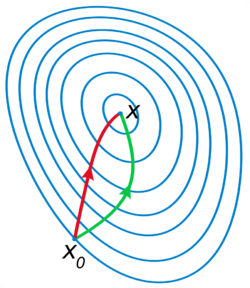🔬 Tutorial problems kappa \(\kappa\)#
Note
This problems are designed to help you practice the concepts covered in the lectures. Not all problems may be covered in the tutorial, those left out are for additional practice on your own.
\(\kappa\).1#
Roy’s identity
Consider the choice problem of a consumer endowed with strictly concave and differentiable utility function \(u \colon \mathbb{R}^N_{++} \to \mathbb{R}\) where \(\mathbb{R}^N_{++}\) denotes the set of vector in \(\mathbb{R}^N\) with strictly positive elements.
The budget constraint is given by \(p \cdot x \le m\) where \(p \in \mathbb{R}^N_{++}\) are prices and \(m>0\) is income.
Then the demand function \(x^\star(p,m)\) and the indirect utility function \(v(p,m)\) (value function of the problem) satisfy the equations
Prove the statement
Verify the statement by direct calculation (i.e. by expressing the indirect utility and plugging its partials into the identity) using the following specification of utility
Envelope theorem should be useful here.
We first show the Roy’s identity.
The value function is \(v(p, m)=\max\{u(x): p \cdot x \leq m\}\) where \(u\colon \mathbb{R}^{N}_{++}\to \mathbb{R}\). The Lagrangian of the maximization problem is \(\mathcal{L}(x, \lambda, p, m) = u(x) - \lambda (\sum_{i=1}^{N}p_{i}x_{i}-m)\). The Envelope Theorem implies
Note, by the way, that here \(\lambda\) is indeed the shadow price of the budget constraint: the slope of the indirect utility along the \(m\) dimension is \(\lambda\)
It follows from the previous equations that
Next, let \(u(x)= \prod_{i=1}^{N}x_{i}^{\alpha_i}\) where \(\alpha_i>0\) for all \(i\). Since \(\log(\cdot)\) function is strictly monotone, the optimization problem is equivalent to maximize \(u(x)=\sum_{i=1}^{N}\alpha_{i}\log(x_i)\). The corresponding Lagrangian is
The first-order conditions yield
Hence, the optimal value function is
To verify Roy’s identity, observe that
Then, we have
\(\kappa\).2#
First, find the maximum and minimum square distances from the origin to the ellipse \(x^2+xy+y^2 = 3\).
Second, using the envelope theorem, approximate these square distances for the ellipse \(x^2+xy+\tfrac{9}{10}y^2 = 3\).
[Simon and Blume, 1994] Exercises 18.2 and 19.12
Use \(x^2+y^2\) as your objective function.
For the first part the problem is:
The Lagrangian is: $\( L = x^2 + y^2 - \lambda(x^2 + xy + y^2 - 3). \)$
The first-order conditions are: $\( L_x = 2x - 2\lambda x - \lambda y = 0 \)\( \)\( L_y = 2y - \lambda x - 2\lambda y = 0 \)\( \)\( L_{\lambda} = -(x^2 + xy + y^2 - 3) = 0. \)$
There are four solutions: $\( (x,y,\lambda) = \begin{cases} (-\sqrt{3}, \sqrt{3}, 2) \\ (\sqrt{3}, -\sqrt{3}, 2) \\ (1, 1, 2/3) \\ (-1, -1, 2/3) \end{cases} \)$
The constraint qualification condition holds at all four solutions. Clearly, the first two solutions are maxima, and the second two are minima.
Now rewrite the problem as:
where \(b = \frac{9}{10}\).
For \(b = 1\), the max is at \((x,y,\lambda) = (\pm \sqrt{3},\mp \sqrt{3},2)\) with \(f^* = 6\); and the min is at \((x,y,\lambda) = (\pm 1,\pm 1,2/3)\) with \(f^* = 2\).
Based on the up to linear term of the Taylor expansion for \(b = 0.9\), \(f^* \approx 6 + (-2 \cdot 3)\cdot(-.1) = 6.6\) at the max and \(f^* \approx 2 + (-(2/3)\cdot 1)\cdot(-.1) = 2 + (2/30) = 2\frac{1}{15}\) at the min.
\(\kappa\).3#
Consider the problem of maximizing \(f(x,y)=x^2+x+4y^2\) subject to the inequality constraint
Using the envelope theorem, approximate the maximum value of \(x^2+x+4.1 y^2\) on the same constraint set.
[Simon and Blume, 1994] Exercises 19.13
As the envelope theorem requires knowing the optimizer and the corresponding Lagrange multiplier, the problem has to be first solved using KKT method.
The Jacobian of the constraint functions is $\( \begin{pmatrix} 2 & 2 \\ -1 & 0 \\ 0 & -1 \end{pmatrix}. \)$
At most two constraints can be binding at the same time, and any \(2 \times 2\) submatrix of this Jacobian has rank two. Therefore, the constraint qualification condition will hold at any solution candidate. Form the Lagrangian
where we convert the nonnegativity constraints to \(\leq 0\) form. Next, write the KKT conditions:
Rewrite condition 1 without minus signs as \(2x + 1 + \lambda_2 = 2\lambda_1\). Along with conditions 7 and 10, this equation implies that \(2\lambda_1 \geq 1 > 0\), and this, by condition 3, implies that the first constraint is binding:
Now we need to examine a few cases. Let’s first look at the case \(\lambda_2 > 0\). In this case, it follows from condition 4 that \(x = 0\), from equation above that \(y = 0.5\), and from condition 5 that \(\lambda_3 = 0\). Plugging \(y = 0.5\) and \(\lambda_3 = 0\) into condition 2 yields \(\lambda_1 = 2\). Plugging \(x = 0\) and \(\lambda_1 = 2\) into condition 1 yields \(\lambda_2 = 3\). So, the assumption that \(\lambda_2 > 0\) leads to the candidate
Now, let’s try the ooposite case \(\lambda_2 = 0\). Cobmining conditions 1 and 2 we find
Substituting \(\lambda_2 = 0\) and \(2x=1-2y\) from above, we find
Combining the latter equation with condition 5 leads to the conclusion that either \(y = 0\) or \(\lambda_3 = 0\), but not both. If \(y = 0\), then \(\lambda_3 = 2\); by the earlier equation, \(x = 0.5\); and by the previous condition, \(\lambda_1 = 1\). If, instead, \(\lambda_3 = 0\), then \(y = 0.2\), \(x = 0.3\), and \(\lambda_1 = 0.8\). Consequently, the case \(\lambda_2 = 0\) leads to the two candidates
By evaluating the objective function at each of these three candidates, we find that the constrained maximum occurs at the point \(x = 0\), \(y = 0.5\), where \(\lambda_1 = 2\), \(\lambda_2 = 3\), and \(\lambda_3 = 0\).
Now, to the answer of the approximation question. Consider the following parameterized version of the problem:
The Lagrangian is
For \(a = 4\), \(x^* = 0\), \(y^* = 0.5\), \(\lambda_1^* = 2\), \(\lambda_2^* = 3\), \(\lambda_3^* = 0\), and \(f^* = 1\). At these values,
so using linear Taylor approximation
